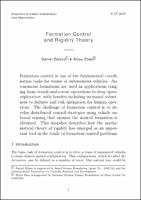| dc.contributor.author | Zelazo, Daniel | |
| dc.contributor.author | Zhao, Shiyu | |
| dc.contributor.editor | Munday, Sara | |
| dc.contributor.editor | Jahns, Sophia | |
| dc.date.accessioned | 2019-12-11T11:07:22Z | |
| dc.date.available | 2019-12-11T11:07:22Z | |
| dc.date.issued | 2019-12-11 | |
| dc.identifier.uri | http://publications.mfo.de/handle/mfo/3689 | |
| dc.description.abstract | Formation control is one of the fundamental coordination
tasks for teams of autonomous vehicles. Autonomous
formations are used in applications ranging
from search-and-rescue operations to deep space
exploration, with benefits including increased robustness
to failures and risk mitigation for human operators.
The challenge of formation control is to develop
distributed control strategies using vehicle onboard
sensing that ensures the desired formation is
obtained. This snapshot describes how the mathematical
theory of rigidity has emerged as an important
tool in the study of formation control problems. | en_US |
| dc.language.iso | en | en_US |
| dc.publisher | Mathematisches Forschungsinstitut Oberwolfach | en_US |
| dc.relation.ispartofseries | Snapshots of modern mathematics from Oberwolfach;2019,17 | |
| dc.rights | Attribution-ShareAlike 4.0 International | * |
| dc.rights.uri | http://creativecommons.org/licenses/by-sa/4.0/ | * |
| dc.title | Formation Control and Rigidity Theory | en_US |
| dc.type | Article | en_US |
| dc.identifier.doi | 10.14760/SNAP-2019-017-EN | |
| local.series.id | SNAP-2019-017-EN | en_US |
| local.subject.snapshot | Discrete Mathematics and Foundations | en_US |
| dc.identifier.urn | urn:nbn:de:101:1-2019121208443475339727 | |
| dc.identifier.ppn | 1685385745 | |


